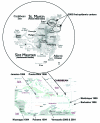Dengue type 3 virus, Saint Martin, 2003-2004
- PMID: 15890134
- PMCID: PMC3320377
- DOI: 10.3201/eid1105.040959
Dengue type 3 virus, Saint Martin, 2003-2004
Abstract
We describe the spread of a dengue virus during an outbreak in Saint Martin island (French West Indies) during winter 2003-2004. Dengue type 3 viruses were isolated from 6 patients exhibiting clinical symptoms. This serotype had not been detected on the island during the preceding 3 years. Genome sequence determinations and analyses showed a common origin with dengue type 3 viruses isolated in Martinique 2 years earlier.
Figures



References
-
- Rice CM. Flaviviridae: the viruses and their replication. In: Fields BN, Knipe DM, Howley PM, Chanock RM, Melnick JL, Monath TP, et al., editors. Virology. Philadelphia: Lippincott-Raven; 1996. p. 931–1034.
Publication types
MeSH terms
LinkOut - more resources
Full Text Sources
Medical
Molecular Biology Databases
